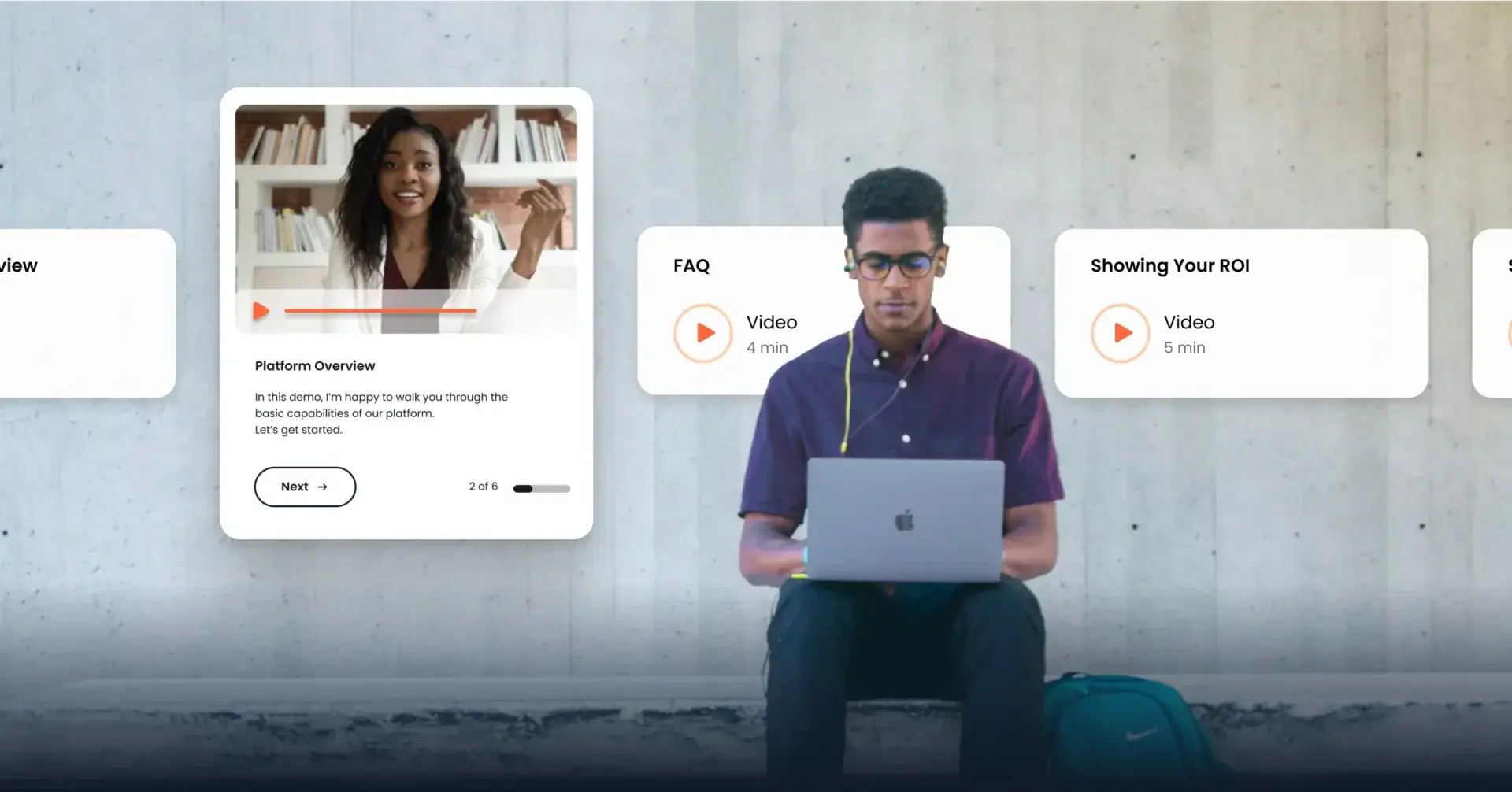Close more deals with
Demo Automation.
Watch a Demo
Every sale, big or small, starts with a compelling pitch. Most B2B buyers don’t engage with sellers until the buying group is 70% of the way through the buying journey. That’s why having a structured approach to communicate your value proposition can be the difference between hooking a new buyer—or that buyer going cold.
This doesn’t mean being rigid and repeating the same highlight reel of features and data. It means being prepared to hit key messaging points, but leaving room for personalization. This is where sales pitch templates can be a game-changer.
Using sales pitch templates ensures you have everything you need to connect with your buyer—a detailed overview of why they should choose your product, featuring custom intel that addresses your potential customer’s specific buyer fears and pain points.
This guide covers the key elements of a strong sales pitch, how to craft your own, and proven sales pitch templates and examples to help you engage buyers and close more deals.
What Is a Sales Pitch?
A sales pitch is a concise, persuasive message designed to convince potential customers to buy your product or service. It’s a way of quickly communicating your value prop, highlighting how you can solve specific customer problems and deliver unique benefits.
Sales pitches can be delivered in different ways, including presentations, emails, phone calls, video messages, or in-person chats. They’re typically short (1-2 minutes, max) to maintain engagement and stay focused on the ultimate goal: to initiate and potentially close a sale.
Why Sales Pitch Templates Are Essential
You have only seven seconds to make a first impression. Well-crafted sales pitch templates help you maximize the quality of those crucial first moments of engaging a new buyer. They also provide structure and consistency across sales teams so that key messaging points are covered in every interaction across all customer touchpoints.
Every pre-made pitch your team shares saves time and money that can be put toward higher-stakes tasks—without sacrificing the quality of individual interactions. Sales pitch templates can be easily personalized in the minutes before hitting send, rather than starting from scratch every time.
Key Elements of a Strong Sales Pitch
The structure of your sales pitch is just as important as the wording you use to sell your product or service. Successful sales pitches typically consist of these main components:
Hook
The opening seconds of your sales pitch need to draw your buyer in. An effective hook addresses something relevant to their industry or specific challenge and is usually formatted in one of three ways:
- Question Hook: “What if you could reduce your customer acquisition costs by 30% while still increasing conversion rates?”
- Statistic Hook: “Did you know that 67% of companies in your industry are losing revenue due to inefficient sales processes?”
- Story Hook: “Last month, a company similar to yours was struggling with lengthy sales cycles until they implemented a solution that cut their time-to-close by half.”
Problem
Clearly articulate your buyer’s industry-specific pain points and challenges to demonstrate understanding and build credibility. The best problem statements resonate emotionally and logically, connecting technical challenges to business outcomes.
Value Proposition/Statement
Clarify what makes your solution unique and how it addresses your buyer’s specific needs. Leading with a statement that highlights the value your solution offers—and the results that can be achieved as a result—helps buyers understand why they should choose it over alternatives.
Differentiate yourself from your competitors by answering the crucial question: “Why you?” For example:
- For many [target audience], [pain point] is a big problem that [negative outcome]. With [product], we help solve [pain point] by [solution 1], [solution 2], and [solution 3].”
- “Others in this space solve [pain point] by [common method of solving pain point], but this [how method falls short] and causes [company setbacks] in the long-run. That’s why our solution uses [different method], which not only solves [pain point], but improves [company goals] so [future setbacks] don’t develop.”
- “Our solution is designed to [problems it solves] and increase [profits/productivity] by up to [percentage] within the first year.”
Solutions
Present your product or service as the specific solution to the previously identified problems. Focus on benefits rather than features, explaining exactly how your solution addresses each pain point mentioned earlier (and using language that resonates with the buyer’s industry and role).
But buyers don’t just want to hear about how great your product is for their company—they want to see it in action. Providing them with a product demo is a crucial step in showing them exactly how your product can solve their problems.
Consider interactive product tours, which kick things up a notch by letting buyers try your product as part of a contextualized guided tour that’s tailored to their specific needs. This makes it easier for them to learn about the key functionality of your product at their own pace—and for you to shorten your sales cycle length by up to 80%.
Proof Points
Mention data, statistics, and measurable results that validate your claims and build credibility. Whether it’s ROI percentages, time saved, or efficiency gained, give buyers concrete reasons to believe your claims.
Tip: Now would also be a good time to humblebrag about company-specific achievements that demonstrate your expertise.
Customer Stories
Provide social proof by highlighting customer success stories that are relevant to your buyer’s industry. Why? 89% of B2B buyers consider peer testimonials to be an essential resource when researching possible solutions.
Social proof leverages the human tendency to seek guidance from others in uncertain situations, like the pressure of investing in just the right product to tackle your company’s biggest challenges. Every case study and review acts as validation that choosing your solution is the “right” move.
Call to Action
Wrap up your sales pitch with a clear, compelling next step that moves your buyer forward in the buying journey, such as scheduling a demo or a follow-up conversation. For example:
- “Subscribe and receive our free guide, [name of guide].”
- “Book a meeting to discover how [product] can boost [company goal] by [percentage].”
- “Are you free for a follow-up call on [day] to go over next steps?”
How to Craft the Perfect Sales Pitch
Beyond structural elements, certain techniques can elevate a standard sales pitch to an exceptional one. These include:
1. Enable Your Buyers
Today’s buyers want self-service tools that enable them to buy when and how they want. They spend only 17% of the buying process in direct contact with vendors, so you need to make it easy for them to learn about your product (and take it for a spin) solo.
This might include providing them with downloadable resources, relatable case studies, and interactive tools, such as automated product simulations and on-demand video demos. That way, buyers can explore your platform pressure-free, and you can nurture interest and surface top buyers—also known as product qualified leads (PQLs)—more efficiently.
Consensus allows you to track lead activity within your product demos and virtual tours. You can then use that activity data to qualify leads for sales and follow-up with them at just the right time, using just the right approach—and close deals up to 3X faster.
2. Build the Pitch Around Your Customer’s Needs and Emotions
Only 13% of customers believe a sales person understands their needs. So it’s critical to take the time to research your buyer’s industry, company, and role before crafting your pitch.
Make it about them instead of your product. Dig into industry-wide challenges they’re likely experiencing, role-specific concerns, and granular-level problems within their individual company. Then, combine logical arguments with emotional appeals by addressing both business outcomes and personal wins for your buyer.
Include thoughtful questions throughout your pitch to help uncover these deeper needs, like:
- What are the biggest challenges your company’s facing right now?
- What are the specific problems you’d like to solve using our product?
- What are your team’s goals for next quarter?
3. Use Storytelling
Start with a compelling hook that parallels problems your buyer is facing, and incorporate narrative elements to engage them on an emotional level. These might include:
- Before/After Scenarios: Contrast life with and without your solution.
- Hero’s Journey: Position the customer as the hero who overcomes challenges with your help.
- Case Study Narratives: Real examples with emotional components.
Post-presentation, 63% of attendees remember stories over tons of numbers or features.
4. Add Stats and Data into Your Pitch
To gain credibility and build trust, incorporate relevant statistics and other data points (like customer stories and testimonials) that support your claims. Present data visually when possible and make sure the numbers directly connect to the customer benefits your buyer is after.
5. Incorporate an Interactive Demo
65% of buyers say that product demos helped them understand the product better than any other advertising method. Interactive demos kick things up a notch, letting your buyer learn about your product in their own way and at their own pace. They can explore features based on their pain points and gain access to dynamic product content—all without adding work for your GTM teams.
Product Experience Platforms like Consensus enable automated, interactive demos that buyers can view on their own time. Buyers tell Consensus the features they care about most, and in return get a personalized video tour that addresses their exact pain points and allows them to envision what it would be like to use your platform. They can even explore your product’s functionality in seconds with a one-click sandbox demo experience.
This empowers them to focus on what matters most to their business—and gives you the opportunity to gather valuable intent data about their priorities so you know exactly when to engage, and how. Consensus users see 50% larger deal sizes, double their number of deals, and reduce their sales cycle by 30%.

6. Personalize the Sales Pitch
Personalized pitches achieve higher close rates than generic approaches, with companies that grow faster driving 40% more revenue from personalization.
Address specific company challenges, use the buyer’s terminology, and reference their industry. Collaborate with sales engineers to fully understand where your buyer is now, what they could potentially achieve by bringing your product into the mix, and provide the tailored technical support necessary to make it happen.
This demonstrates genuine interest and understanding, particularly when personalizing pitches for technical audiences.
Sales Pitch Templates with Examples
The following sales pitch templates can be adapted for different sales scenarios and customer types. Each template serves a specific purpose in the sales process—simply customize it to fit your offering and target audience.
Sales Demonstration Pitch
A standard sales demonstration includes product context, competitive advantages, and implementation details. Focus on your buyer’s specific use case and demonstrate how your solution addresses their unique challenges using effective demonstration techniques, like on-demand demos.
“After analyzing your current workflow challenges, I’ve prepared a quick demo that shows how our solution integrates with your existing systems to eliminate the bottlenecks you mentioned. Unlike competitors who require complete system overhauls, our approach preserves your current investments while adding the capabilities you need. Here’s how…”
Product Demo Pitch
A product demo pitch focuses on showcasing your products’ features and benefits in a way that resonates with specific buyer needs. Structure your demo with an introduction, key features demonstration, benefits explanation, and clear next steps.
“Hi [name], based on our conversation about your challenges with [specific pain point], I’d like to show you how [your product] addresses this through [key feature]. Our customers like [similar company] have seen [specific results] after implementing our solution. Let me walk you through how it works specifically for your situation…”
Make your demo interactive and focused on solving buyer problems rather than just showing features. With Consensus, you can deliver a full-funnel product experience to your buyers that engages multiple senses and gives them the chance to watch, try, explore, and track their interactions.
- Watch: Visually captivating demos that showcase your product’s capabilities and give them a taste of what you offer.
- Try: Hands-on tours that allow buyers to learn about your product as it relates to their specific needs.
- Explore: Interactive product simulations that provide a scenic route of your platform and offer the option of taking your product for a spin.
- Track: Buyer interactions generate actionable insights for sales teams that can be used to both accelerate the sales cycle and continuously improve product experience.

Learn more about how Consensus can take your company’s product demos to the next level.
Email Sales Pitch
Email pitches are about capturing attention quickly with compelling subject lines, preview text, and concise value propositions.
Subject: “Solving [company]’s [specific challenge]” or “[Mutual connection] suggested we connect about [specific goal]”
“Hi [name],
I noticed [company] recently announced plans to expand your [specific initiative], and I thought of you because we helped [similar company] overcome similar challenges during their expansion.
Our [product/service] has helped companies in [industry] achieve [specific result] by addressing [pain point]. For example, [customer example] saw [specific metric improvement] within [timeframe].
Would you be open to a 15-minute call this week to discuss how we might help with your expansion goals?
Best, [your name]”
Phone Sales Pitch
Phone pitches require a clear introduction, reason for calling, qualifying questions, and a compelling next step.
“Hi [name], this is [your name] with [company]. We help [target industry] companies like yours [solve specific problems/achieve specific results]. I noticed from your recent [announcement/LinkedIn post/website] that you’re focusing on [relevant initiative].
Many of our clients in [industry] struggled with [common challenge] before working with us. Is that something your team is experiencing too?”
Adapt your tone and pacing based on the buyer’s responses, and be prepared to handle common objections with confidence and evidence.
Presentation Sales Pitch
A sales presentation pitch involves a slide deck that aesthetically supports your message with a clear structure, attention-grabbing text, and compelling visuals.
“Today I’ll show you how [company] helps organizations like yours address [pain point] and achieve [desired outcome]. We’ll look at the challenges you’re facing, how our solution addresses them, and the results other companies in your industry have achieved. By the end, you’ll understand exactly how we can help you [achieve specific goal].”
Limit slides to 10-15 for a 30-minute presentation and make sure you:
- Introduce your buyer’s pain points: “For many [target audience], [common problem/pain point] is getting in the way of [ideal outcome].”
- Describe the problem’s impact to amp up emotional ROI: “In the last year alone, this has caused a drop in [ideal outcome, e.g. conversions/revenue] by [percentage].”
- Present your solution and how it works: “Our [product/service] can help solve this problem by [solution 1], [solution 2], and [solution 3]. [provide a quick demo]”
- Highlight data that supports its effectiveness: “These are just some of the impressive results [industry] companies have achieved since signing up with us. [present data]”
- End with an irresistible CTA: “Sign up today and receive [percentage] off your first year” or “Are you free for a follow-up call next after you’ve looked over the data?”
Don’t forget to sprinkle time throughout to listen to your buyers and ask timely sales questions.
Website Sales Pitch
Website copy functions as an always-on sales pitch that quickly communicates value and drives action. Visitors spend just 10-20 seconds on a webpage before deciding whether to stay or leave.
What makes them stick around? Pages with a clear value proposition.
Structure your page with attention-grabbing headlines, concise value propositions, visual elements, customer testimonials, and compelling CTAs that coach instead of sell.
“[Company] helps [target audience] achieve [desired outcome] without [common pain point]. Our [product/service] provides [key benefit 1], [key benefit 2], and [key benefit 3], resulting in [specific result]. Join over [number] companies who have already [achieved specific outcome].”
The Follow-Up Pitch
Follow-up templates help you maintain momentum after initial contact, meetings, or when deals have gone cold. Most sales require multiple follow-ups, yet many salespeople give up after just one attempt.
Reference previous conversations, add new value with each touchpoint, and create appropriate urgency without being pushy (use these tips for B2B sales reps to stand out even more).
“Hi [name], I’m following up on our conversation about [specific topic/pain point]. Since we spoke, I found this [relevant resource/case study] that addresses the [specific challenge] you mentioned. I thought it might be helpful as you consider options for addressing [pain point]. Would you be open to a quick call this week to discuss how we’ve helped similar companies solve this issue?”
Elevator Sales Pitch
A 30-second elevator pitch works for networking events, brief encounters, or the beginning of longer conversations. The most effective elevator pitches focus on the listener’s needs rather than the speaker’s accomplishments.
“We help [target audience] solve [specific problem] through [unique approach], resulting in [specific benefit]. Unlike traditional solutions that [common limitation], our approach [key differentiator]. For example, we recently helped [similar company] achieve [specific result] in just [timeframe].”
The “Hook” Pitch
Hook-focused templates capture attention quickly—particularly useful for cold outreach or competitive situations with skeptical decision makers involved. Tailor your hooks to specific industries and buyer personas for maximum relevance and impact.
“Did you know that companies in [industry] are losing an average of [amount/percentage] due to [common problem]? We’ve developed a solution that has helped organizations like [reference customer] reduce this by [percentage] in just [timeframe]. Would you be interested in learning how we might be able to do the same for [buyer company]?”
Problem/Solution Pitch
Problem/solution pitches emphasize the buyer’s challenges before introducing your solution. Research industry-specific problems thoroughly and position your offering as the ideal solution with concrete evidence.
“Based on our research and conversations with similar companies in [industry], we’ve identified three critical challenges you’re likely facing: [challenge 1], [challenge 2], and [challenge 3]. Our [product/service] addresses these by [solution 1], [solution 2], and [solution 3], resulting in [benefit 1], [benefit 2], and [benefit 3].”
Here’s an example challenge/solution/benefit chart you can use as a jumping-off point for your next pitch.

Unique Selling Proposition Pitch
Center your USP pitch template around key differentiators that separate you from competitors and use them to make a straightforward argument for your solution. What makes your offering truly unique and why should that matter to buyers?
“While most solutions in this space focus on [common approach], we take a different approach by [unique methodology/technology/philosophy]. This allows us to deliver [unique benefit 1] and [unique benefit 2] that others simply can’t match. For example, [customer example] achieved [specific result] after switching to our solution from a competitor.”
Voicemail Sales Pitch
Keep voicemails under 30 seconds, use an energetic but natural tone, and always include a clear reason for calling and your contact information.
“Hi [name], this is [your name] with [company.] I’m calling because we helped [similar company] [achieve specific result] in [timeframe], and I thought we might be able to do something similar for [buyer company]. I’m going to send you an email with more information. If you like what you read and think it makes sense for your business, you can reply to the email or give me a call back at [your phone number]. Thanks, and I hope to chat with you soon.”
Video Sales Pitch
Personalized video sales pitches receive higher response rates than generic videos and standard emails.
Besides using scriptwriting to bring your pitch to life, keep videos under 90 seconds, include personalized elements like your buyer’s website or LinkedIn profile, and make sure there’s good lighting and audio quality.
“Hi [name], I wanted to take a minute or two to show you something specific about how [your product] could help with the [challenge] we discussed. As you can see on my screen, this is how [feature] works to address [specific pain point]. Our customers like [similar company] have used this to [achieve specific result]…”
Social Media Sales Pitch
Personalized connection requests with a clear value proposition receive higher acceptance rates. Adapt your messaging for platform-specific best practices on LinkedIn, Twitter, and other social platforms.
“Hi [name], I noticed your recent post about [topic/challenge]. At [company], we’ve helped organizations like yours address this through [approach/solution], resulting in [specific outcome]. Would you be open to a brief conversation about how we might be able to help [buyer company] achieve similar results?”
Storytelling Pitch
Create narrative-based sales pitch templates that use story structure to engage buyers emotionally. Incorporate customer journey, challenges, turning points and resolution into a compelling narrative that will stick with your audience long after your pitch is over.
“When [similar customer] came to us, they were struggling with [specific challenge] that was costing them [specific impact]. Their team had tried [common solution] but kept running into [common obstacle]. After implementing our [product/service], they were able to [key achievement 1] and [key achievement 2], ultimately resulting in [business outcome]. We’d love to help [buyer company] achieve similar results.”
Call-to-Action Sales Pitch
Develop a selection of CTA templates that align with different pipeline stages and encourage immediate action without being pushy.
“Based on what we’ve discussed about your [challenge/goal], I recommend we move forward with [specific next step] to help you achieve [desired outcome]. We can have this up and running by [specific date], which would put you on track to see results by [timeframe]. Would you like to go with [option 1] or [option 2] to get started?”
Make the Perfect Sales Pitch
Effective sales pitches combine structured templates with thoughtful customizations that address your buyer’s specific needs.
Consensus helps sales teams deliver perfect pitches through interactive demos that buyers can explore on their own time. By combining demo automation technology with actionable buyer intent data, Consensus enables more personalized follow-up conversations based on what buyers actually care about.
Experience a demo to see how Consensus can help your team close deals faster with the personalized product experiences that modern buyers crave.
Sales Pitch Template FAQs





